Cor à Pistons
|
Label:
|
Millereau | |
|
Model:
|
Cor à Pistons | |
|
Serial Number:
|
none | |
|
Date of Manufacture:
|
ca. 1870? | |
|
Key(s):
|
Eb (Other keys depending on crook) | |
|
Valves:
|
3 Perinet removable sauterelle (Right-Handed) | |
|
Bore:
|
11.5 mm | |
|
Bell Flare:
|
Very wide gussett | |
|
Bell Throat:
|
7.5 cm | |
|
Bell Diameter:
|
27.4 cm. | |
|
Base Metal:
|
brass | |
|
Finish:
|
raw brass | |
|
Acquired from:
|
England | |
| Prior to establishing himsef as a brass instrument maker
in Paris in 1861 François Millereau worked for Besson. Within
a year he was advertising Sax horns made under license and by 1873 he was
offering a full line of woodwinds as well as brass instruments. In
1878 he bought the patterns of Marcel AugusteRaoux from Jacques Christophe
Labbaye. Labbaye had bought the rights to the Raoux name and horn
patterns twenty-one years earlier and had continued to make horns under
that name. Labbaye continued in the employ of Millereau.
The dating of this horn is problematical in that there is no address given
nor does the Raoux name or marque appear anywhere on it. Later Millereau
horns are labelled "Raoux-Millereau" to capitalize on the famous name and
reputation.
A most unusual aspect of this horn is that it is built to be played using the right hand to operate the valves with the bell facing left. This is opposite to the standard orientation and is very uncommon. |
||
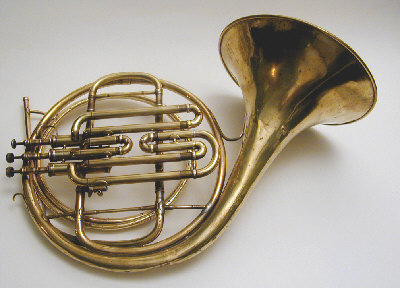 |
| The above view is actually the front (i.e. audience side) of the horn and the player's side is shown below. Note that the valves are on the near side in the above photo. Normally they would be to be on the opposite side of the horn and fingered with the left hand. |
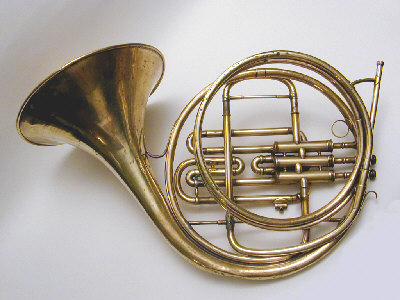 |
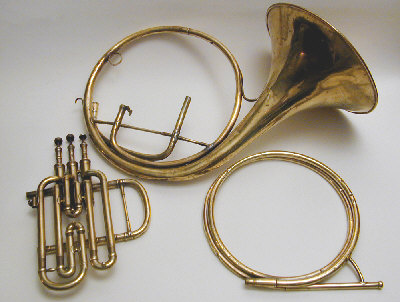 |
| The components of the horn are shown above. At the top is the corpus, to the left is the sauterelle valve section, and to the right is an Eb terminal crook that was supplied with the horn. The sauterelle is removeable to allow the horn to be played also as a natural with an appropriate tuning slide and coupler (not included here). |
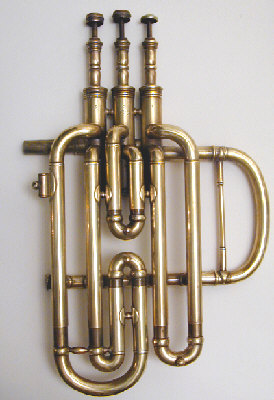 |
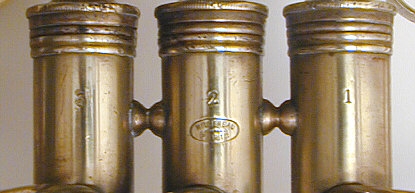
The sauterelle valve section is clearly made for playing with the right-hand and only fits the horn in that manner. The numbers stamped on the front of the valve casings (above) correspond to the usual nomenclature for valved brass instruments: (from right to left) the first valve (index finger, right hand) lowers the horn a whole tone; second (middle finger) lowers a half tone; third (third finger) lowers a tone and a half. In France it was popular to have an ascending third valve to raise the horn a tone and Millereau offered horns of that design as an option. |
||
| This sauterelle is also unusual in that the distance between the legs of the tuning slide is less than the distance between the legs that are inserted into the horn. Normally these distances are equal so that a single tuning slide can be used either with the sauterelle or with a coupler (not included here) for use as a natural horn. The coupler would be simply a pair of parallel tubes joining the tuning slide to the horn. One other unusual aspect is that the tuning slide is slightly tapered, having a larger diameter at the valve side (upper side in the picure) than on the crook side. This serves to continue the conical nature of the horn but for most horn designs the tubing is usually cylindrical through the tuning slide and valves, and only taperedl in the crook and bell sections. | |||
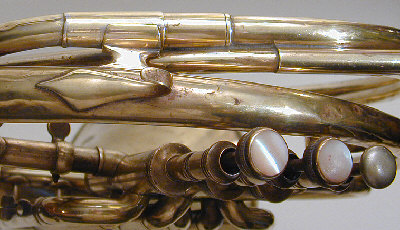
|
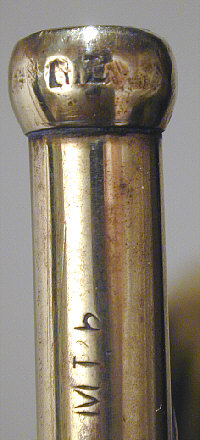
The crook itself is a standard Eb terminal crook and has the letters CL (or perhaps GL) stamped at the mouthpiece receiver (see above right). This might indicate crook was made by (Jacques) Christophe Labbaye who remained in the employ of Millereau after selling him the rights to the Raoux name and business in 1878. |
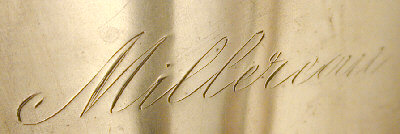 |
|
| The label on this horn is simply "Millereau" and is inscribed on
the top of the bell flare next to the bell brace. This is unusual in that
the maker's label is more often found on the bottom of the bell flare or
along the garland if one is present. This is the only identification
on the horn except for the name "Millereau/Paris" found on the sauterelle
(see above). It is possible that the space was left on the bottom
of the bell to leave room for the name of a dealer or importer to be "stenciled."
The absence of any reference to Raoux suggests that tha horn was made prior
to 1878.
Below is a 1910 advertisement from Herman Schoenaers who was Millereau's son-in-law and who took over the business in 1898. Note the endorsement of François Brémond. Before becoming professor of horn at the Paris Conservatory, Brémond had been an active player in Paris. He reinstituted the valve horn class at the conservatory and urged his students to play with the valves in the right hand and the bell to the left as was his own practice. The advertisement includes an option to purchase a Millereau horn with right hand valves (outlined in red, below). |
|
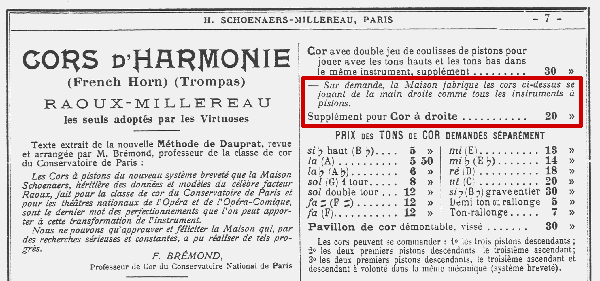 |
|
References
Larigot Nr. 11, l'Association des Collectioneurs d'Instruments à Vent, Paris, September 1992,William Waterhouse, The New Langwill Index, Tony Bingham, London, 1993
Contents of this site and all original photographs copyright 1999-2002, Richard J.Martz
All rights reserved.